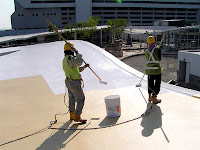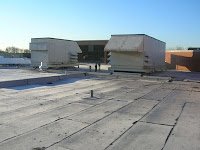White roof coatings like those from Conklin can be applied to practically any roofing membrane or system. They are commonly applied to sprayed polyurethane roofs, metal roofs, single-ply rubber roofs, and modified bitumen roofs. They can even be applied to certain kinds of asphalt built-up roofs.
It is important to establish compatibility between the white coating and the underlying roof surface. Manufacturers recommendations should be consulted for detailed information about specific coatings.
Primers & Surface Preparation
Primers are useful for improving adhesion between roof surfaces and coatings or for imparting additional properties to the roof coating systems. For example, a rubber roof coating may provide better adhesion to a rubber roof membrane or better permeability (“perm”) rating on a sprayed polyurethane roof. Most white roof coatings impart greater reflectivity and UV protection to the system.
Manufacturer literature should be consulted and followed to properly prepare the surface for the coating. Professional roofing contractors should be employed for most coating installations. For certain systems, contractors may need to be specially trained by the manufacturer in the application of the coating. Proper application of the roof coating factors strongly in the subsequent life and performance of the coating.
Surfaces should be clean and dry, and they must have a positive slope to drains. Application of white coatings over dirty, wet, or contaminated surfaces may produce unsatisfactory results. Acrylic latex coatings are sensitive to dew, rain, and other moisture during curing. It is important that the application be done with strict adherence to the manufacturers recommendations.
Application
Coatings are typically applied by airless spraying, rolling, or brushing. Due to the variety of coating types, climatic conditions, and surfaces to be coated, it is important to consult the manufacturer for proper application rates and related recommendations.
Find a Contractor here
ROOFING CONTRACTORS NEEDED IN MULTIPLE STATES!
It is important to establish compatibility between the white coating and the underlying roof surface. Manufacturers recommendations should be consulted for detailed information about specific coatings.
Primers & Surface Preparation
Primers are useful for improving adhesion between roof surfaces and coatings or for imparting additional properties to the roof coating systems. For example, a rubber roof coating may provide better adhesion to a rubber roof membrane or better permeability (“perm”) rating on a sprayed polyurethane roof. Most white roof coatings impart greater reflectivity and UV protection to the system.
Manufacturer literature should be consulted and followed to properly prepare the surface for the coating. Professional roofing contractors should be employed for most coating installations. For certain systems, contractors may need to be specially trained by the manufacturer in the application of the coating. Proper application of the roof coating factors strongly in the subsequent life and performance of the coating.
Surfaces should be clean and dry, and they must have a positive slope to drains. Application of white coatings over dirty, wet, or contaminated surfaces may produce unsatisfactory results. Acrylic latex coatings are sensitive to dew, rain, and other moisture during curing. It is important that the application be done with strict adherence to the manufacturers recommendations.
Application
Coatings are typically applied by airless spraying, rolling, or brushing. Due to the variety of coating types, climatic conditions, and surfaces to be coated, it is important to consult the manufacturer for proper application rates and related recommendations.
Find a Contractor here
ROOFING CONTRACTORS NEEDED IN MULTIPLE STATES!









